Traffic Signals Not Racist
Sometimes, a cigar is just a cigar.
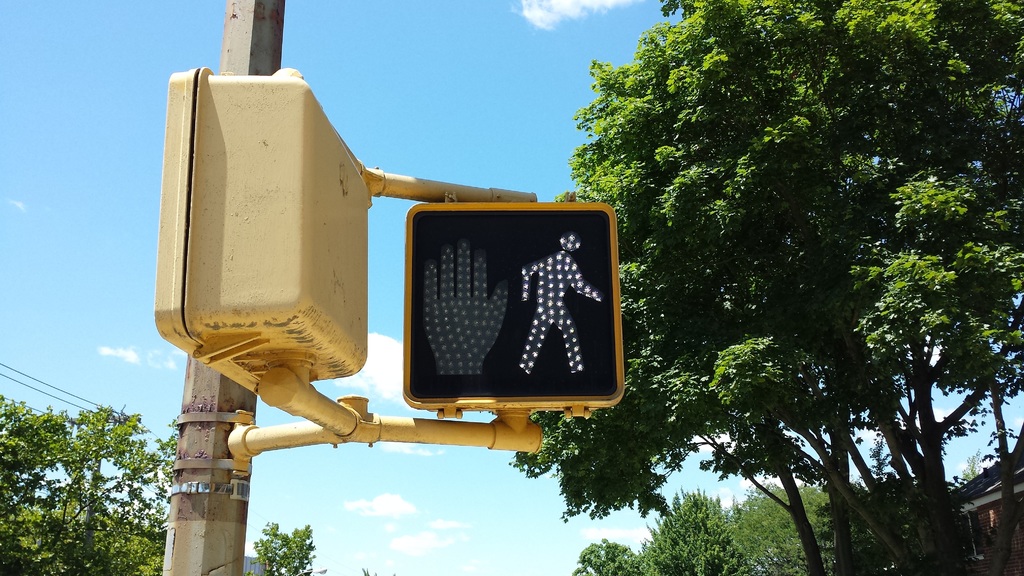
Perhaps the aggregators at memeorandum were trolling me this morning, linking me to a Medium post that no one else seems yet to be discussing. Regardless, the headline “The Unintentional Racism Found in Traffic Signals” was too much to ignore.
Indeed, not being familiar with David Kaufman’s oeuvre, I’m honestly not sure whether this is supposed to be serious or a clever satire of the moment:
A few months back, before Covid-19 kept us in our homes and George Floyd made us take to the streets, I was walking with a friend, her daughter, and my twin sons. My friend is White and I’m not — something I’d never given a second thought until we reached a crosswalk. “Remember, honey,” she said to her daughter as we waited for the light to turn green, “we need to wait for the little White man to appear before we can cross the street.”
I realize that White people like to exert control over nearly everything everyone does, I thought, but since when did this literally include trying to cross the street?
Part of my surprise here was a function of age. My boys are a few months younger than her daughter and we hadn’t yet tackled the “crossing the street” component of basic toddler training. But as a Black dad, I was struck by the language at play. How is it possible that well into the 21st century, parents all over Manhattan — well-meaning, #BLM-marching parents — are teaching their children to ask “little White men” for permission to cross the street? And why doesn’t this seem to bother them?
Because it’s a race-neutral traffic signal? But, apparently, it actually did bother Kaufman:
It certainly bothered me — so much so that I began to dig deep into my fortysomething consciousness to try and remember if I was raised asking a little White guy to let me cross the street. Were these the words my progressive White mother used to teach her little Brown children the fundamentals of pedestrian safety? Turns out, I wasn’t raised this way — and neither, most likely, were you.
He recalls that, in the beforetimes, traffic signals had words on them. He did some research and found out that we’ve slowly been taking words off of signs to make them universal, replacing them with symbols. (I’ve known this for decades, but probably paid more attention having spent some of my childhood and young adulthood overseas and thus being more tuned in to international signage. Indeed, I had to learn them to get licensed to drive in Germany 31 years ago.)
In fact, the Walking Person’s first major move actually took place in 1971 when it became enshrined in the Manual on Uniform Traffic Control Devices — the FHWA bible — as an alternative to the words “WALK” and “DON’T WALK.” For the next four decades or so, our little friend slowly, informally replaced its outdated predecessors until 2009; that’s when the Walking Person finally became the FHWA standard and, as the spokesperson says, “the option to use words is no longer permitted in newly installed signals.” One day soon, every traffic signal will contain the Walking Person, along with its counterpart: the bright red hand telling folks not to walk.
So the “little man” is actually a little person, but that little person is still white. Right?
Close. It’s “lunar white,” according to the [Federal Highway Administration (FHWA)]: a shade of white with yellow and grey accents that mimics the color of the moon. Lunar white wasn’t chosen because it sounds cool. According to FHWA research, the agency spokesperson says, moonlight offers “the peak sensitivity for the rod cells in the human retina.” In other words, our vision is predisposed to favoring the clarity and intensity of moonlight.
In the end, it’s not that the Walking Man is so super-duper white. Rather, his true competitive edge is that he’s super-duper bright. “The use of bright colors… offers the greatest contrast against a dark background,” the FHWA spokesperson says. “They do not lend themselves to confusion with other colors [and] are thought to provide the greatest level of comprehension and safety.”
And there you have it: The government-approved origins of the “little White men” telling us to cross the street at corners across New York. Thanks to help from the FHWA, I am now convinced that technology and necessity, rather than some anti-Black conspiracy, propelled the shift from verbal crosswalk cues to a lunar-white Walking Person. But my heart still sinks at the specter of teaching my sons to ask a White man for permission to do — well, anything. Because so much of the world already insists that we do.
Granting that the very nature of systemic racism is that it’s often so incredibly subtle as to be easily unnoticed, looking for it in traffic signals seems a stretch. (Indeed, when I saw the headline I was expecting some argument about the subtle racism of the green-amber-red hierarchy.)
Still, given the extent race does play an outsized role in American life, I’m fine with this:
At a time when the totems of systemic anti-Blackness are being dismantled at a surprising pace, there comes a moment when you have to consider the endgame. And traffic lights are one of those moments. Because while this highly politicized period does demand a racial rethink, overhauling the stoplight industrial complex is probably not the best use of our resources. A White man isn’t really telling us when to cross the street, even if we hear a friend blithely expressing it in those terms.
Nonetheless, that little White man woke me up to the ways that language imparts power and privilege even upon the most banal necessities. And so, as I begin teaching my boys survival basics like riding a bike, waiting in line, and… yes… crossing the street, I’ll work hard to avoid phrases like “little White man.” Obviously “bright light person” rolls off the tongue far less mellifluously, but a bit of extra verbal labor is worth the price of not conceding our power to even one more little White man.
Honestly, I don’t think I ever used the phrase “little White man” when teaching my girls how to cross the street.

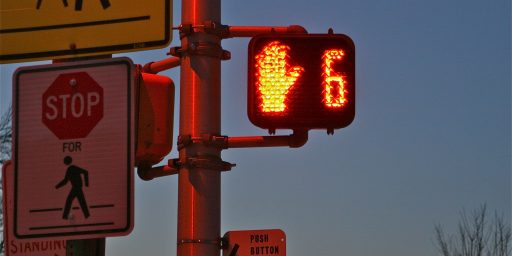
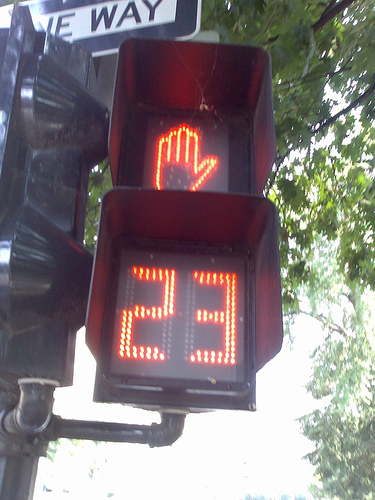
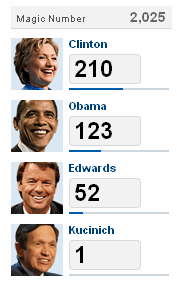

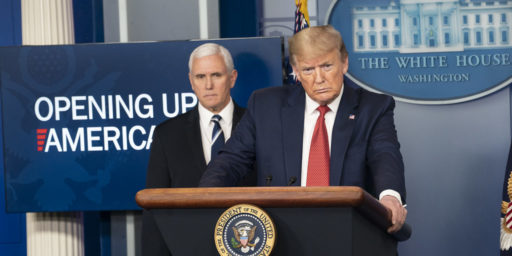
I’ve never, ever heard any of my friends use “little white man” when teaching their kids about traffic signals either.
This is the type of thing that just goes too far and pushes people to not take these issues seriously, because it seems grasping at straws, trying to find offense where there is none.
Lest anyone go the “why isn’t it green/red” angle: for the same reason that many traffic signals now have a border around them: because people who are colorblind have trouble discerning changes in red/green lights.
As to ” waiting for the little white man to tell me it’s OK to cross,” if I was black? Yeah, I’d probably have a problem with that phrase as well. Hell’s bells, I’m white and it grates.
Color blindness has no effect on one’s ability to see shapes.
“So how was work today, David?”
“I swear to God this writer’s block is going to kill me. You should see the piece of crap I phoned in today. Christ. If I don’t get my shit together they’re going to fire me.”
I went in expecting to roll my eyes harder at that essay based on the title, but ultimately, I appreciate (but don’t fully agree) with where he took it. He gets credit in my book for doing this history work if nothing else. And I do think it says something about the reality of living under systemic racism in so much as that you do find yourself parsing everything. But taking that conclusion to it’s full extend also points out a different issue with the essay.
Ironically, I think it also becomes a great example of how our personal blinders cause us to miss bigger arguments. In focusing on the topic of racial equity, he actually misses the bigger argument about unintentional design ideologies.
The shift from “walk” to “the little man” was an attempt to make the overall system more accessible (by removing English from the equation). If you’re really committed to making an argument that that attempt at making things more accessible has an unintended norming effect, I think the far better critique is that it maintained an “ableist” view of the purpose of a traffic crossing — i.e. that’s it specifically for walking (i.e. on two legs). People in “wheelchairs” for example, don’t “see” themselves in that icon (or at least that’s my understanding from disability rights communities).
Before going further, I get that this is an extreme critique. I don’t think we need crossing lights that extend multiple feet into an intersection to accommodate iconography for all forms of potential crossing (though I that feels like should be a gag in a Zucker/Brooks style movie).
My only point is to highlight how someone’s position (and focus on a topic like systemic racism) causes them to miss (or at least not write about) other “-isms” that are prevalent.
This. Which is why using accessible iconography is so good (arguably better than the Traffic light which requires understandings of the positional relationship of the lights to interpret the design).
FWIW, a fully “accessible” crosswalk design would work with an “X” for no crossing (or possible the “circle-hash no” sign) and an “up arrow” in the direction to proceed when it’s ok to cross). That said there would be a design challenge/restriction as to whether or not making those shapes clearly visible would force a larger box and if there would any traffic safety implications to that.
This is pretty ridiculous, of course.
But what it does illustrate is that pretty much everybody starts laughing and pointing when anti-racism (or political correctness in general) goes a bit overboard.
The ridicule and disapproval isn’t nearly as universal when it goes a bit too far in the opposite direction. Then – more often than not – it’s just some unfortunate locker room talk, gramps grew up in a different time, etc., etc.
Contrary to the not-so-politically correct, the politically correct are expected to get it right immediately.
Perhaps this is not entirely fair.
@mattbernius:
That’s fair. Speaking from a position of ableist privilege, it makes sense to be to use a relatively universal symbol that’s instantly understandable. The overwhelming number of people crossing are in fact going to be walking. But, yes, it’s also a subtle reminder to those in wheelchairs, or missing a leg, or whatever that they’re “not normal.”
I don’t know what the solution is to that, or whether we need one.
We have, at least done a much better job in recent years of making intersections wheelchair-accessible.
@James Joyner:
Yup. And that’s how ideologies/blindspots about what is “universal” or “normal” get baked into design systems.
Agreed, though there’s still a lot more work to go on that. Which also gets to a point that there’s also an order of priority for communities. And while the disability-rights community might complain about any microaggression from the “walking person” icon, they are far more concerned about getting wider curb cuts that actually go all the way to the street (versus having a bump that can tip a wheelchair) or provide people who have mobility issues with ample time to cross a busy crossing (especially navigating other people crossing).
Changing the signal icon without doing the other is ultimately empty change.
I’ve never heard anyone admonish anyone to “wait for the little white man to tell you to cross.” I’ve never thought it.
The comments after the article almost uniformly ridicule it.
@OzarkHillbilly: @mattbernius: Oh the things that get lodged in one’s brain over decades! I believe that years ago there was a sort of tradition in (as I heard it) Southy Boston that the Irish couldn’t stand seeing red lights at the top of the fixture and green lights at the bottom. So they used slingshots until Boston learned it’s lesson and corrected that error. No one thought too much of color-blind-disabled folks in those primitive days.
I think this is called “running around with a chip on your shoulder looking to find something to be offended about.”
(And I’ve never heard the term “the little white man” when referring to the WALK signal, either.)
I suppose we should now all have a hissy fit because the icon isn’t wearing a skirt, because there are more women than men in the U.S. population? And then someone else can have a hissy fit because wearing skirts vs. pants demonstrates gender roles….
@mattbernius: As someone who has designed products for an international market, having an acceptable iconography is a huge blessing. You don’t tinker with it as people are trained to look for certain symbols and can interpret them even when seen out of context. I actually remember when the now universal symbol of a red circle with a slash through it came into being. We now recognize immediately that we are not supposed to do/bring the thing it is superimposed over, but that was not immediately accepted at the time. I know the in the US there was a lot of debate and suggestions for improvement, s0me of them pretty angry. The standards bodies held firm and I’m glad they did.
I remember having a discussion with a Chinese colleague about the potential difficulties caused by the fact that the color red is universally used to denote danger in the Western world, and just as universally used for good things in Asia.
@CSK:
That was my reaction too. It seems so awkward a phrase I wonder if it actually happened. I don’t remember what I told my kids, other than “‘Wait for the walk sign” but if I got more creative than that, “Wait for the walking man to light up” seems a lot more natural…
@MarkedMan:
I wouldn’t be at all surprised if this never happened. It really, really strains credulity.
I read Kaufman’s piece as having a gently humorous tone. I think this piece is much more a way to express the internal dialogues and feelings that a black person might have to a broader audience than it is advocacy of reform of traffic signals. It’s also a raised eyebrow at the friend’s referral to the traffic signal as “the little white man”, something I would never do, and neither would Kaufman.
The dismissvie phrase “woke sh**” was positively invented for this type of thing.
Never in my life have I ever heard in “little white man” – little walking man yes. Or variations on that (in different languages), but white man…
now one could have a boring Gender argument about Man versus Woman as noted above, but really… To have a readily legible sign one needs visual simplicity. The outline of a person works.
@Jay L Gischer:
Do you believe the friend actually referred to “the little white man”? Because this is the absolute first time I and everyone else have heard or seen such a locution.
I am surprised by you having a “white man” for walking instead of a “green man” (like in Portugal). I was convinced that the combination used in Portugal (“walking green man” for walk, “standing red man” for wait) was universal.
I think we should absolutely get right on this issue of colors in Walk/Don’t Walk signs. Because there’s absolutely nothing more important going on.
@Michael Reynolds: As long as the green man goes first!
@CSK: It’s in quotes. Absent other information, yes, I think she said that. I know a few people who might unthinkingly say exactly that. And what Kaufman is pointing to is that unthinking quality that so many white people have, even if they are liberal and friendly.
I’ve read other black people complaining about similar things. They know it isn’t a big thing, but it chafes them.
@OzarkHillbilly:
If I take off my glasses and had to make out the glowing shape of a hand vs. a walking dude across a four lane street, I wouldn’t be able to.
WHY DO YOU HATE THE DIFFERENTLY ABLED YOU FUCKING MONSTER? WHAT IF I COULDN’T AFFORD GLASSES? WHY DO YOU HATE POOR PEOPLE?
Good user interface design uses as many cues to differentiate these things as possible. There may be other solutions, but removing color completely isn’t a good one.
Reporting in from a predominately white Fairfax Va suburb of the 1980s. This AA never heard of the comment:“we need to wait for the little White man to appear before we can cross the street”
@robert sharperson:
I really doubt if anyone has. The danger of a story like this is that it serves as a convenient excuse for white people to dismiss all the legitimate grievances Black people have.
I find it interesting that so many folks here think this man is being overly sensitive to the phrase “wait for the little white man to tell you it’s OK to cross”, especially seeing as this is a country where “not asking the white person permission” to sleep gets the cops called on you,
where “not asking the white person permission” to BBQ, gets the cops called on you,
where “not asking the white person permission” to shop, gets the cops called on you,
where “not asking the white person permission” to wait for a business associate before ordering one’s coffee, gets the cops called on you,
where “not asking the white person permission” to go to the store and buy some tea and Skittles gets you shot,
where “not asking the white person permission” to jog thru their neighborhood gets you shot.
I could go on, but I think you get my drift.
@Gustopher: The little town I live near just put in a new lighted intersection with cross walks. Guess, what, you can be totally blind and safely cross because it has audible cues (“Walk, walk, walk, Don’t walk, don’t walk, don’t walk…). But then what about the Helen Kellers of the world, eh?
I don’t know about you, but as far as I can see, white people don’t need a convenient excuse to dismiss black people’s grievances. It comes as natural as breathing.
@Lounsbury:
Indeed … 🙄
@OzarkHillbilly:
I think you can see from the tenor of many of the replies on this thread, starting with the very first comment by Jen, that even intelligent, well-intentioned people are getting a little exasperated. If everything is racist, then nothing is racist. What’s trivialized is easily dismissed.
@OzarkHillbilly:
My issue is not with the author being “overly sensitive,” it’s with the bonkers initial phrasing. The more I think about it, the more the issue seems to be with the weirdness of that one person using the phrase, rather than the traffic signal.
@OzarkHillbilly: More cues are better. We have some here that have an odd whistle thing going on, and if I was dependent on it, I might even learn what the various whistles mean.
Colors are a useful signifier though. If it was a white background with a black man, I don’t think anyone would complain about it — although for some low vision colorblind people (there are multiple types and degrees of colorblindness), the block of the white background might resemble the general shape of the don’t walk hand.
This stuff has to be carefully tested, and what we have works reasonably well.
School crossing signs tend to be black figures on a yellow background. I don’t think many people assume only black kids can cross there.
@MarkedMan:
100% to this. Red is a great example of the fact that “universal design” really isn’t possible. Or rather, it’s possible but requires deciding that one culture’s interpretation is “right” (and someone elses isn’t).
Beyond that, I both agree with the following statement AND also suggest that it points to that just like any other language, iconography is fluid and can (and does change).
Again, I’m really not arguing that we need to change the “walk” icon, but your story demonstrates that if it was to be replaced by an arrow (as an example) that could ultimately come to be accepted (especially given how we interpret meaning through context clues).
@mattbernius: Yes, a strong point. We largely adopted European signage as ‘universal’ starting decades ago. Then again, with so much manufacturing in Japan and later China and elsewhere in Asia, we’ve expanded that far more.
I personally hate that we’ve moved from words to pictographs even though I fully support the goal of doing so. But I really suck at deciphering most of them. Car dash boards and various electronics have tons of them, many of which is less than I intuitive for me.
@OzarkHillbilly: but color, you fool.
@Miguel Madeira: I remember green man walk signals in the US. I don’t know why, but they were hard to see at sometimes of day and some types of atmospheric conditions–heavy fog being one as I recall. The lunar white is very much more visible.
I grew up with “WAIT”/”WALK” and “DONT WALK”/”WALK” signals and didn’t teach any children how to cross the street, so I got no dog in this fight at all. I recall being told “wait for the signal” when I was very young and even crossing only with red/green spot signals–no pedestrian signal at all. Maybe that’s why whoever it was referred to Seattle as a “cultural wasteland” back in the 50s.
ETA:
If I don’t have my glasses on, I can’t see that there’s a signal at all. Or even an opposite side of the street. Quit complaining, snowflake! 😀
@OzarkHillbilly: Does it have different sound effects/voices for N/S vis a vis E/W? The signals here–what few exist and are kept maintained–have chirping one direction and “ding-dong” sound the other in addition to the voices. Ours say “Wait” rather than “Don’t Walk” and you have to activate the signal to get instructions. (We don’t really have very many pedestrians here at all. Everybody drives everywhere. We get in our cars to drive across the street to the convenience store to buy cigarettes.)
Now that that’s out of the way lets tackle the racism of Pool. The White ball is the centerpiece of the game and gets to knock all the other Colored balls off the table–culminating with the elimination of the Black ball.
Black balls matter….
@MarkedMan
“I remember having a discussion with a Chinese colleague about the potential difficulties caused by the fact that the color red is universally used to denote danger in the Western world, and just as universally used for good things in Asia”.
um…no.
red is popular in china; it’s a mixed bag elsewhere in asia.
and even in china, traffic signals conform to international norms. there’s no one thinking “oh good, fortuitous red– must mean go!!”
i was not really aware red meant danger in the west, for that matter. it does on the light simply b/c that’s what we learn. light could have been purple and silver, for that matter. just arbitrary colors chosen long ago.
@Just nutha ignint cracker: different tones for different directions is pretty common in Japan. Also so are the “Tenji blocks” indicating that one is at a curb. Actually invented in New Zealand quite some time ago, then was picked up by other countries.
It’s pretty telling that the figure – which shows no genitalia or other indicators of sex, is presumed to be a “man”.
That’s the default, just like white is the default.
We don’t need to make a big deal about it, but we do need to be aware of these defaults and adjust our perceptions a bit.
My opinion is that is personal work we need to do within ourselves, and calling out others is unhelpful.
@Tony W:
Most of them look male. The one pictured atop the post looks like a man in a sack suit and fedora. Many others are more generic but have a bald or buzzcut head and a blocky torso. Some cities have gone with female figures and there are a lot of variants.
It’s come to this. It’s actually come to this.
A couple weeks ago I made a comment on WaPo to the extent of, “some people would see ‘white supremacy’ if they opened a carton and saw white eggs.”
It sounds like tongue-in-cheek, but I was spot-on.